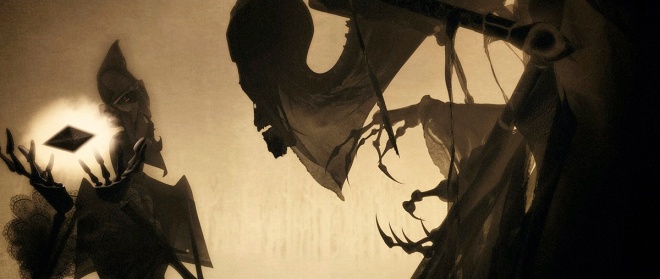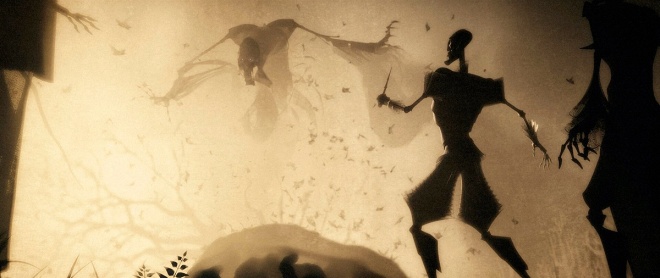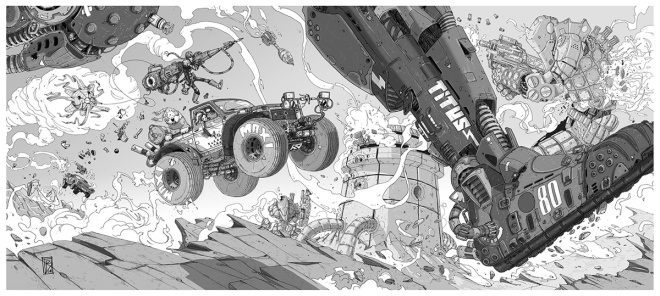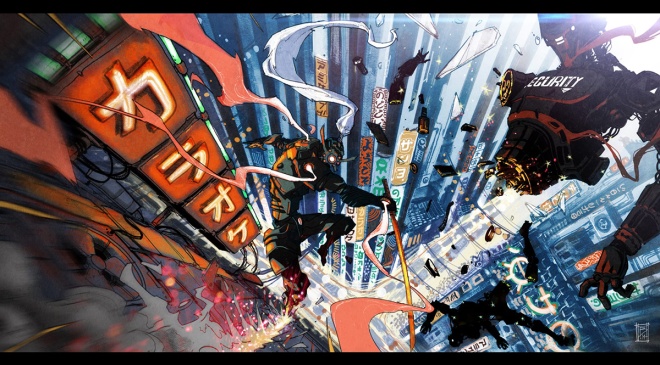‘Tale of Three Brothers’ director Ben Hibon on his next creative adventures at Luma Pictures
Posted in: Animation
Director Ben Hibon’s works are pieces of animation that tend to stick in your mind for months or years. From his breakthrough short Codehunters to the masterful Harry Potter ‘Tale of Three Brothers’ sequence, Hibon has brought a definitive style to the animation he’s directed.
Now he has joined Luma Pictures as their head creative director, at a time when the studio that most people know as a visual effects shop is also branching out into animation, its own features and other content.
I recently got the chance to sit down with Hibon to discuss his journey in animated content, and about the plan at Luma.
vfxblog: Can you talk about how you got into directing animation?
Ben Hibon: I grew up in Switzerland and I was always, always, always drawing. Drawing has always been the base of everything I’ve been doing for the last 35. I did some animation when I was a teenager on my Amiga, and so there was always a desire to draw worlds, and then at some point a desire to animate them or to put them into motion. Still, I never pursued film or animation as an education. But very early on I went into fine art.

Now, fine art is such a frivolous and such a hard industry. It’s like fashion. You really have to find a voice – you can say the same for films, there’s only a few people who get to make films. The big thing when I was starting was graphic design. That was like the cool, upcoming thing that was just sprouting up everywhere in Europe. And the Mecca for that was London, so in 1996 I went to the Central St-Martins School of Art and studied there.
What was really great about doing graphic design was that it was a little bit of illustration, a little bit typography, a little bit of photography, a little bit of layout. When I graduated it was still the early days of the internet, and the big thing to do animation with was Flash. And so I started playing with these tools and falling back into my old ways of animating and using the program to make little animations. It turned out that Flash was a great way to do animation and be able to send it around because file sizes then still had to be really small.
I made a short film in 2001 that was kind of very dynamic and had a lot of camera movement, and that just went crazy on the Internet.
vfxblog: Was that Full Moon Safari?
Ben Hibon: Yeah, Full Moon Safari, that was my breakthrough thing. Agencies saw it in Japan, and I started working in Japan like crazy. And suddenly I also started working in animation whereas before I was a graphic designer designing websites and things like that. So all that allowed me to make more and more things – animation, music videos.
vfxblog: You had success with Codehunters in 2006, too. What did that lead into?
Ben Hibon: I made the short film for MTV Asia, and it went around a lot of festivals and was pretty active and very visible on the internet. One day I got a call from a producer, from a Hollywood producer, and he called me and said, ‘Hey, I’ve seen your short film, really great stuff, would you want to make movies? If so I’m talking about you to agents and managers, you’re gonna get phone calls.’ And I had all these guys who literally called me the next day and said, ‘Hey, you want to sign that thing you have online?’
So I suddenly had agents and managers. But it was a very slow process and I’m living back in London, and my agent from WME called me and says, ‘Hey I’ve got a producer from Harry Potter and I’ve just given him your reel. Is that okay if he gives you a call?’ I was like, ‘Yeah, great.’ I mean, this was completely out of the blue. Then half an hour later I get a call from David Heyman, the producer of the Harry Potter series, and he says, ‘Hey, we love your work, we’d love to meet you in London. The director, David Yates, would love to talk to you about a sequence if you’re interested in directing something for Harry Potter.’
So I sat down with David Yates and we had an hour meeting with Stuart Craig, the production designer as well. They had very, very few references. They had like a couple of things that they liked, including the Austrian animator Lotte Reiniger who had done a lot of that shadow puppetry with paper cut-outs.
vfxblog: Obviously that Harry Potter project is The Tale of the Three Brothers. How did you then conceive what this all should look like?
Ben Hibon: Well, I went off and storyboarded it based on the few pages they gave me from the book, and that was it. There was no pitch, there was no competition. They really wanted to find someone to take it off their hands with the right sensibility and make something heartfelt, with a lot of texture – something that was warm and truthful to the world of Harry Potter.
One thing I wanted to do with it was make sure the audience would be very much a spectator. So we had these seamless transitions that would surprise you but not in an abrupt or an upsetting way. The narration was already very well-paced and extremely rhythmic so it was very important to not disrupt that with cutting. I thought the cameras should be floating, and the transitions should be very, very smooth and very soft. The idea was that you would be surprised all the way through and then you would just discover things within other things like a wondrous little journey where you’re just sitting back and just watching.
vfxblog: The sequence was almost immediately lauded for having a very hand-made feel, which it certainly did, but of course it was made in cg by Framestore.
Ben Hibon: Yes, I’d done a lot of cg work but I’ve always tried to retain some artistry, some texture, some feeling of imperfection in the work I do. I love cg, I love 2D, but I also love the powerful design element of animation – the fact that you can animate so many styles. And that’s how the shadow play idea came into it. I was looking at Thai and Asian shadow play animation which was beautiful and mesmerizing stuff. Which meant we could have silhouettes and also have projected shadows on the canvas. And then we could play with a candle-lit quality to the lighting, almost a flickering kind of lighting that gives a beautiful vignette to everything.

vfxblog: Why did you decide to join Luma?
Ben Hibon: Well, I think of all the different companies in this industry working in animation, vfx, and commercials, they really seem to be the one studio that is super forward-thinking. They are trying to really understand where this is all going, how the industry might change, and what is going to be their place in this new space.
They’re putting their incredible tech and artistry and knowledge of technology to really trying to figure out what’s the coolest, most creative thing we can do with the great tools that we have as opposed to just repeat and redo what they do so well. And that’s very liberating for not just for me but also for the people already working here.

vfxblog: Can you outline what your role at Luma as head creative director involves?
Ben Hibon: I don’t know if there’s a good description. Being head creative director overall is about making sure the company has a very current visual quality. And making sure that the standards of work that is put out is of a certain quality, which they already obviously do. But, as they want to expand, and as they want to venture into directing and producing their own material, and as they want to engage with storytelling, then there’s an ideology that you start to put forward.
When you’re only a service company, you’re at the service of other creative entities, and then you respond to briefs, and you iterate. But if they’re going to be putting out their own ideas and their own IPs, then they need to have some sort of strong vision. And of course I’ve been involved with directing animation for 15 years, so I think that I’ll be wanting to carry on that in whatever format that ends up being.

For more info on Luma Pictures, head to their website at www.luma-pictures.com.
For more info about Ben Hibon, check out his site at www.statelessfilms.com.

Post a Comment